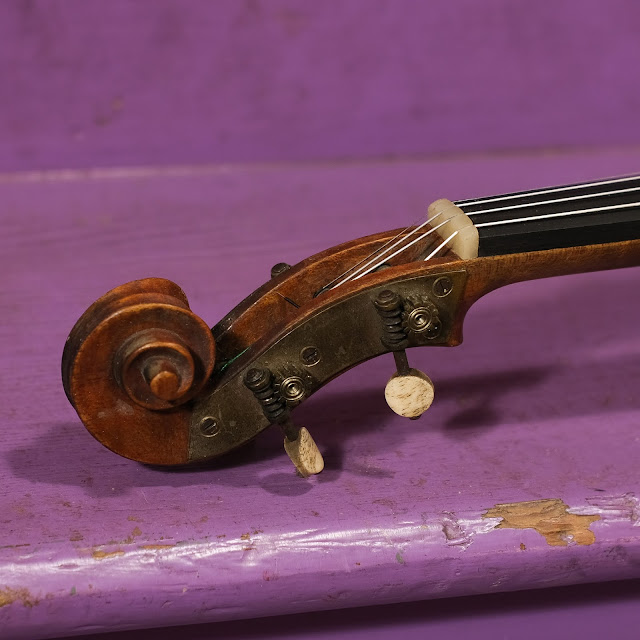1900s Unmarked German-made 4/4 Violin
A customer of mine brought in an armful of violins and asked me to "get two ready for him." This one was by far the ugliest (it was filthy) but, on quick inspection of quality, it was also by far the best choice for "first" of the batch.
It looks German-made to me and came here with no fittings except for the tuners (which date it to around 1890-1900). It needed a fingerboard, nut, bridge, tailpiece, endpin, and chinrest. There were also some old repairs done but a number of new repairs were necessary as well.
It's lightly-built and has a thinly-cut top which is a little flatter than average in its arch. The same is true of the 1-piece, flamed maple back. All of these little design changes add-up to an instrument that is loud and punchy but yet husky and woody at the same time. It has a lot of warmth and double-stops sound rich amd full on it.
The guitar-style violin tuners (they've got bone buttons!) were a bit of a fad at the time and they're seen on upper-mid-grade instruments for the most part. I honestly wish that they'd caught-on as they look nice, work well, and don't really add any weight or tonal difference compared to ebony pegs. Cork-sniffers -- feel free to lodge complaints with that statement. From my point of view, though...? Whatever makes it easier to stay in tune makes it easier and more convenient to play and that will make one play more.
Repairs included: new fingerboard install, new bone nut, tuner lube/overhaul, seam repairs, minor crack re-repairs, new chinrest, new tailpiece, fit new bridge, restring, setup.
Made by: unknown
Made in: probably Germany
Top wood: solid spruce
Back & sides wood: solid flamed maple
Bridge: maple
Fingerboard: ebony
Neck wood: maple
String height: fast/low fiddle-style
Strings: John Pearse Mezzo (like Thomastik Dominants)
Neck shape: medium C
Neck relief: straight
Scale length: 12 5/8"
Nut width: 15/16"
Body length: 14"
Body width: 8"
Body depth: 1 1/2"
Weight: 1 lb 3 oz
Condition notes: it's very beat-up/scratched throughout and has a repaired hairline crack on the back and a couple of old repairs to hairline cracks on the top. The seams are a little "slipped" here and there but all glued pat. It has a number of replacement parts but all new fittings are ebony.















Comments